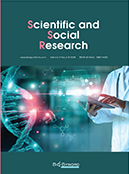Abstract
The spatial distribution of cardiovascular disease patients in Yangzhou City and the impact of different
community environments was analyzed in this study. Spatial methods like kernel density analysis were used. Results show significant spatial clustering of cardiovascular disease patients within Yangzhou City. The study evaluates the impact of dining environment, culture and entertainment, healthcare, education, and technology on cardiovascular diseases. It was found that dining environment impacted people within a 500 m radius, while culture, healthcare, and education environments impact within 1 km. The influence of the industrial environment is smaller, requiring a 3 km range for significant effects. These findings aid urban planning and community development and helps in formulating measures to improve the residents’ cardiovascular health.
References
Bauwelinck M, Zijlema WL, Bartoll X, et al., 2020, Residential Urban Greenspace and Hypertension: A Comparative Study in Two European Cities. Environ. Res, 191: 110032 https://doi.org/10.1016/j.envres.2020.110032
Hu CS, Wu QH, Hu DY, et al., 2017, Novel Strategies Halt Cardiovascular, Diabetes, and Cancer Strips. Chronic Diseases Translat. Med, 3(3): 159–164.
Lee M, Brauer M, Wong P, et al., 2017, Land Use Regression Modelling of Air Pollution in High Density High Rise Cities: A Case Study in Hong Kong. Sci. Total Environ, 592: 306–315.
van Dam PM, 2021, The Role of Machine Learning in the Early Detection of Cardiovascular Disease in a Community Setting. European Heart Journal. Digital Health, 2(1): 135–136.
Raskind IG, Kegler MC, Girard AW, et al., 2020. An Activity Space Approach to Understanding How Food Access is Associated with Dietary Intake and BMI Among Urban, Low-Income African American Women. Health Place, 66: 102458.
Weng M, Ding N, Li J, et al., 2019, The 15-Minute Walkable Neighborhoods: Measurement, Social Inequalities and Implications for Building Healthy Communities in Urban China. J. Transport Health 13: 259–273.
Xie B, Jiao J, An Z, et al., 2019, Deciphering the Stroke–Built Environment Nexus in Transitional Cities: Conceptual Framework. Empirical Evidence, and Implications for Proactive Planning Intervention. Cities, 94: 116–128.
